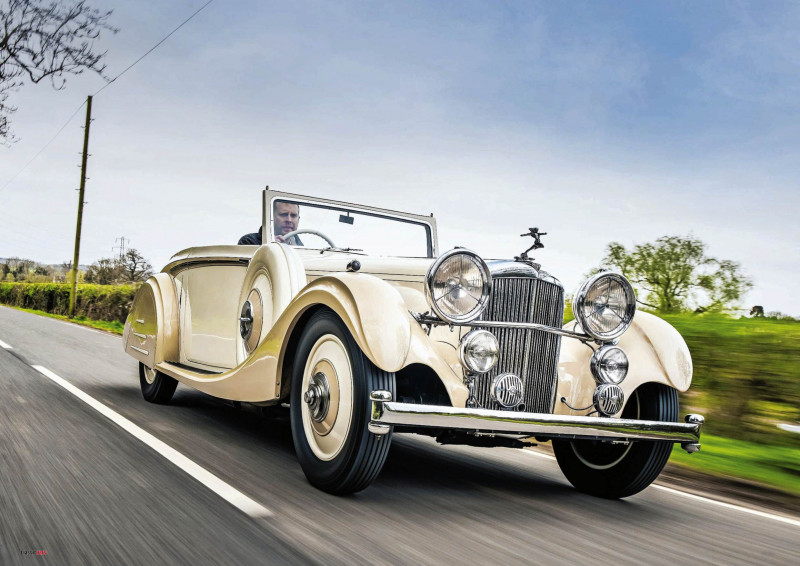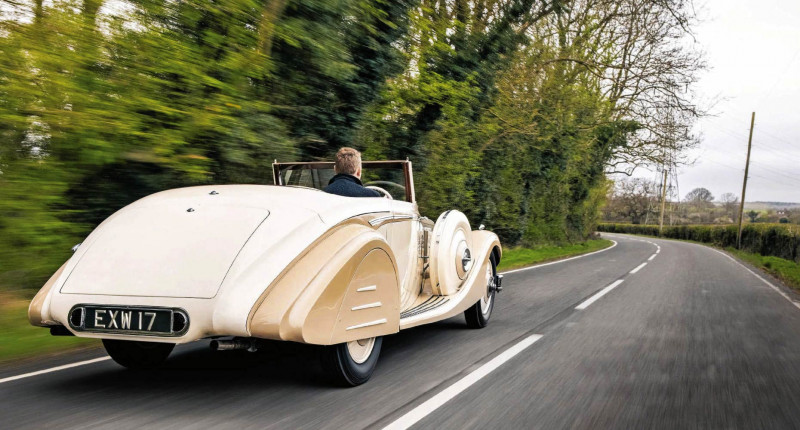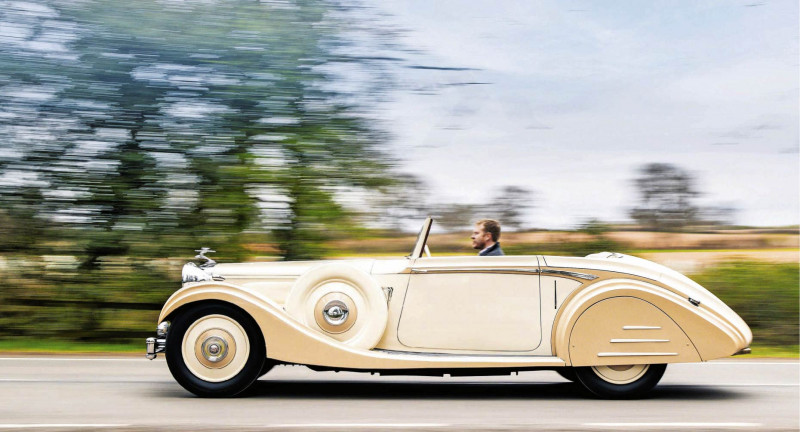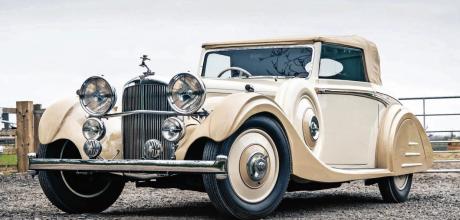1937 Alvis Speed 25 Lancefield
For art’s sake? In contrast to the cheerful, functional Alvis models of the Twenties, coachbuilders conjured striking grand routiers on Thirties Alvis chassis. None is sleeker than this unique Speed 25. Words Nigel Boothman. Photography Jonathan Fleetwood.
Unique Lancefield Alvis driven
Art For Art’s Sake? On the road in the beautiful art-deco Lancefield Alvis Speed 25
You wouldn’t think so to look at it, but there’s a large, muscular animal concealed in that gown-like coachwork of this Alvis. The straight-six, triple-carburettor ohv engine seems larger than its 3571cc reality, both in the sound it emits and the amount of urge available. It ticks over with a polite burble, but if you keep your foot down rather than short-shifting through the easy synchromesh gearbox, the volume rises and a lovely, throaty growl emerges, hardening as the revs increase.

And it really does go. The performance of any Twenties or Thirties car tends to be one of the following: embarrassing, adequate or caddish. Here, we’re firmly in driving-like-a-cad territory. The figures don’t sound dazzling today, with 0-50mph coming up in ten seconds, but when 50mph was all that most cars could manage and 40mph was a more normal cruising pace, even on trunk roads, it was electric. Within a few minutes of setting off in this long, low machine, you’re hunting for dawdlers on a straight stretch of road. A drop into third gear, perhaps an unnecessary double-declutch and a bark of revs, then swing out and storm past.
British didn’t do deco? This Alvis will make you think twice

All the way to 97mph, in theory. Speed Model Alvises, especially the larger 3.5-litre and 4.3-litre models, are all luxury expresses so the acceleration and effortless high-speed cruising shouldn’t be a surprise. What’s distracted us here is that extraordinary body. It’s almost too decorous to be fast… you’d hardly expect a bride to hitch up her wedding dress and hurdle a gate.
The bodywork was constructed during the late summer of 1937 by the London coachbuilder Lancefield for the Earls Court Motor Show, opening on 14th October that year. Compared with some of the more venerable outfits, Lancefield was a fledgling firm, exhibiting for the first time in 1929 at Olympia but soon making a name for itself. A craze for aircraft-inspired, modernist forms had been intensifying since the Twenties and it came to a head with a sudden bloom of streamlined car designs that appeared across the world in 1934. Lancefield was very much a part of this, exhibiting fastback two- and four-door Alvis saloons. One, on a Speed 20, even attempted faired-in headlamps, giving a chubby-cheeked look.
Lancefield then went further with an ungainly full-width design on a Hudson chassis, which ended up so wide that it fitted four across the front seat – one outside the driver – while an incredibly rakish body on a Siddeley Special chassis suggested a young stylist set free with a blank sheet and a set of French curves. The point is this – innovative streamlined design is one thing, making it beautiful is quite another. But by 1937, it achieved that aim with perfect success when it created this car.

Nick Walker summed it up well in his A-Z of British Coachbuilders, ‘Some of these streamlined creations look ugly to modern eyes, but Lancefield was also quite capable of producing designs which are as stunning now as the day they first emerged from the works. Supreme amongst these must be the concealed-head coupé of 1937-’38, first shown on a Speed 25 Alvis at the Earls Court Show and subsequently applied to Bentley, Mercedes, Lagonda and Hotchkiss chassis.’ Of those, only the Bentley example looked markedly similar to this Alvis, and then a little less sporting thanks to the Bentley’s higher bonnet line. A large part of the success of the design comes from not messing about with the car’s handsome face. The shape, size and position of the Alvis radiator relative to the front axle line, those huge Lucas P100 lamps, the Silver Eagle mascot and the two spotlamps would look good almost anywhere, so we must move a little further back for the magic touches. Both front and rear wings have a fluted line scalloped into the top outer edge, something that must have created twice as much work for the panel maker and which was originally picked out in red amongst the beige and ivory. Perhaps this over-stated the effect as subsequent owners haven’t chosen to repeat it, but the scalloping in the wings sets up the sculptural quality of the car’s tail perfectly.
We have recurring teardrop shapes – look at the rear wing with the spat covering most of the wheel. It’s a teardrop on its side, with the lowermost 40% cut off. A few inches further in, the shape is repeated, but an inch or two larger, where the petrol filler emerges on the nearside. A half-step further and we see the shape repeated again by the falling line that begins in front of the door handle, and then it repeats for a final time by using the car’s waistline to fall away through the lighter paint on the boot, right to the tip of the tail. The three strakes along each spat might as well be the speed lines cartoonists use to add ‘whoosh’ to a moving car.
With that unaltered radiator and lamp treatment you have to admit that the aim has moved from cheating the wind to pleasing the eye, though the concealed hood arrangement achieves both. It was another vogueish idea in the mid-Thirties and there were many solutions, albeit few as elegant as this.
If it’s coming on to rain, or if high-speed roofless motoring is about to mess up an expensive hairdo, you release the close-fitting steel tonneau panel behind the back seat via a key inserted into the small hole in its centre. Raise it carefully and with a colleague on the other side of the car, lift the hefty roof frame upwards. There are out-folding arms that swing forward to create the top of the window channel above each door and to latch with the header rail. Close the tonneau panel and you’re done. It’s a lined, luxurious arrangement and with the windows up it does a convincing impression of a fixed-head coupé; it feels warm and weatherproof. On the other hand, you’re suddenly aware of all the exhaust boom and gear whine that was escaping straight up in the air…it’s now bouncing around the cabin, so the Alvis is actually noisier with the roof up than down. Driving the car, while exciting, also reminds you just how far we’ve come in the last 84 years. You sit behind an enormous wheel, necessary to give some purchase on steering that becomes lorry-like at low speeds, but which exaggerates the amount of play when the effort lightens with pace. Nonetheless, the seats are deliciously comfortable and create a good driving position, hampered only by a handbrake under one knee and a gear lever under the other, if you’re long in the leg. In truth, any thought of ergonomics was decades away, so the narrow aperture between the seat and A-pillar means you can hardly get your feet in and out.
It turns heads like few other cars, though nobody knows what it is. Even within spitting distance of the present Alvis Car Company headquarters in Kenilworth and a short jog down the road from the old Alvis works in Coventry, we only get one correct guess from passing dogwalkers all day. Why? Hard to say, but it feels as though people can’t believe anything this glamorous is British without being a Rolls-Royce or a Bentley, never mind native to Warwickshire. Someone suggests Mercedes.
Perhaps it’s understandable. After all, no-one remembers how millionaires of the Thirties caught special trains from London to Scarborough to go big game fishing for 700lb tuna, so why should anyone be aware of the magnificent British cars they drove when on dry land? Lagonda, Invicta, Armstrong-Siddeley, Marendaz, Talbot, SS, Atalanta, Sunbeam, Railton, MG, Jensen, British Salmson, Brough Superior and of course Alvis all made powerful chassis available as glamorous open four-seaters. And we could include the purer sports cars like Frazer Nash, Aston Martin, Lea Francis and Riley, too.
Alvis, like many other firms mentioned above, established itself in the Twenties with medium-priced four-cylinder models. A versatile chassis and a wide choice of coachwork allowed the company to build on a sporting reputation earned at Brooklands circuit, while genuine innovation wasn’t far behind with the front-wheel-drive 12/75 road model of 1928, based on earlier front-driven racing cars. Alvis sold its first conventional rear-wheel drive six-cylinder chassis the year before and by 1932 it had developed extensively into the 2511cc-powered Speed 20.
The Speed models nailed down Alvis’s place at the top table, with increased engine capacity and technical advances (not least independent front suspension and the world’s first all-synchromesh gearbox) arriving soon to propel the later models into direct rivalry with Derby Bentleys and 4½-litre Lagondas. As well as Lancefield, all the well-known British coachbuilders of the era got their chance to show what they could do on Alvis chassis, with the most exalted being the dozen Vanden Plas short-chassis 4.3-litre tourers. Mind you…there’s only one Lancefield drophead like this.
It’s impossible to spend long in the driver’s seat without concocting fantasy trips or appropriate missions for this car. Bends in the B4113 become sinuous curves leading down to a holiday in the Loire… brake, downshift, load up the steering and power through, tyres just starting to squirm as the torque does its job. It’s a great big charismatic thing and not really suited to pottering (or even thundering) along country lanes in Warwickshire. But thanks to the pandemic, any thoughts of posing with admiring crowds outside an Art Deco casino or giving lifts at Ascot on Ladies’ Day will have to wait. In the meantime, with abundant grunt and excellent brakes, we can give a few moderns something to think about.
It may be a glimpse of a vanished world, this car, but we can only enjoy that glimpse thanks to the efforts of Alan Stote to bring it home to UK. Alan is the proprietor of Red Triangle, the Alvis specialist based at the firm’s old service department in Kenilworth, and of the re-formed Alvis Car Company on the same site. He located the Lancefield Speed 25 in California nearly 30 years ago, but before that, it had seen a few adventures.
‘I know it was in the London showroom for quite a while after the Earls Court show,’ says Alan. ‘I once met the son of one of the Lancefield partners and he remembered being taken to school in it, so it definitely didn’t sell immediately.’
This could be down to the weighty price. We don’t know what the full total was, but Alan’s educated estimate of £1200-£1300 would have required a wealthy customer at a time when a semi-detached house might cost £250. However, the car did eventually find a home and remained in private hands in the UK for another 25 years or so, before turning up in Kingston, Jamaica in 1967. In the late Seventies an American collector bought it and it moved to Los Angeles. He must have appreciated what he had, because the car was allowed out onto the show circuit, being selected as ‘one of the world’s most beautiful cars’ for the Autoshow der Superlative, Veedol Starparade, in Berlin in 1982 and then for an appearance at the Pebble Beach Concours d’Elegance in August 1983.
Next it was owned by a film company, in the hands of two rather eccentric and secretive individuals resident in Switzerland and California. It dropped out of sight for a decade. ‘I was aware of it because I like unusual coachwork,’ says Alan. ‘A friend in America managed to track it down in 1993 and found it was in storage with some Bugattis and all sorts of other cars, down in San Diego. I flew over to attend the Hershey autojumble and Laguna Seca, and we went to see it. I never met or spoke to the owner, but my friend ended up taking phone calls from him, calling from all over the world, once or twice a month until the deal was finally done in 1994. Some collectors can be unusual characters and you have to be patient and persistent.’
The car was wearing a variation on its original colour scheme, but in salmon pink. The Ace wheel discs had gone, so despite its basically sound condition, Alan treated the car to a repaint back to Earls Court show colours and acquired the correct discs to finish the look. As Alan’s involvement with Red Triangle and eventually the launch of the Alvis Car Company took over, the Lancefield dhc was both a personal treasure and an asset to the business. It’s been shown around the UK and in France and then travelled on exhibition to Dubai in 2015 and to Japan in 2017, which led to the first order for a Continuation version (see boxout previous page).
As we crawl back through Kenilworth’s traffic to put the car away, it’s tempting to leave the last quote to one of the men responsible for this high-water mark of British motoring glamour. Bob Gaisford, along with his brothers Harry and Edwin and their partner George Warboys, founded Lancefield Coachworks in 1922. In old age, he spoke to a previous owner of the car, who passed this nugget on to Alan Stote. ‘Of all the cars my brothers and I designed,’ said Bob, ‘the concealed drophead coupé was my favourite.’ After a day with it, taking in this unique blend of Alvis performance with Lancefield’s artistry, I can see why.
1937 Alvis Speed 25 Lancefield
- Engine 3571cc in-line six-cylinder, ohv, three SU side-draught carburettors
- Max Power (est) 115bhp @ 4000rpm
- Max Torque (est) 175lb ft @ 2000rpm
- Transmission Four-speed manual, rear-wheel drive
- Steering Marles worm-and-roller steering box
- Suspension
- Front: independent by lower wishbones, upper transverse leaf spring and friction dampers.
- Rear: live axle, leaf springs, friction dampers.
- Brakes Drums front and rear
- Weight (est) 1524kg (3360lb)
- Performance 0-60mph: 13sec
- Top speed: 97mph
- Fuel consumption 18mpg
- Cost new (est) £1250
- Value now (est) £350,000-£400,000
‘It joined the show circuit, being selected as “one of the world’s most beautiful cars”’
CONTINUING THE BREED
Alan Stote reformed the Alvis Car Company in 2012 to begin limited manufacture of select classic Alvises, one of which is this Lancefield model. And no, it’s not built on a modern platform or powered by a 21st-century powerplant, it’s manufactured using the original Works drawings for the ladder chassis and powered by an Alvis 4.3-litre engine, with the crankcase, block and head freshly cast in the Black Country. The 4.3-litre was always externally identical to the Speed 25 engine and was available as an option in period, so if you can have the performance from an extra 700cc, why not? ‘It’s well underway at the moment,’ says Alan. ‘We digitally scanned the car and from that, we’ve been able to make an ash frame for the body. The chassis and engine have been done, so we’ll be on to the panel work next.’
Despite the modern tech involved in capturing the car’s shape in 3D, the skills employed in turning it into metal are entirely old-school, with everything coach-built by hand as it was in period. So Alan’s team will soon be facing the same challenges posed to Lancefield’s workers when they were presented with sketches like the one shown above – this original rendering and others like it will form part of the reference from which they work. ‘We are the Alvis Car Company and we’ve started building cars again in exactly the same way. We’re using the same drawings and methods as we did up to 1967 – it’s just been a long time between orders.’
The only concession to modern times will be a fuel injection system to allow the car to meet emissions standards – as trialled on the firm’s already completed, Japan-destined Continuation Vanden Plas 4.3 tourer – and a six-speed manual gearbox.
Potent 3.5-litre straight-six fed by twin fuel pumps Handle for built -in jacks below wheel mallet.
‘People can’t believe anything this glamorous is British without being a Rolls-Royce or a Bentley, never mind native to Warwickshire’
Speedo may not function, but engine note speaks volumes Steering wheel controls not a modern phenomenon Torque arrives at 1000rpm, real drama from 2500rpm Clean wood-capped line resembles a motor launch.
‘The strakes along each spat might as well be the speed lines cartoonists use to add “whoosh” to a moving car’


